|

    
  
THE ISSUE: FOOD ACCESS AND INSECURITY
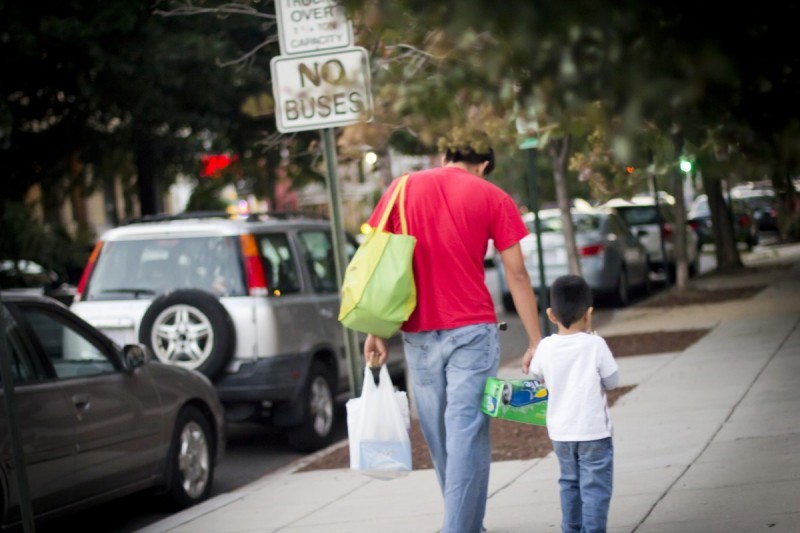 Historically, malnutrition and hunger have almost always been seen as an issue within both the nation and New Jersey. However, over the past decade new focus has been given to addressing why this issue effects entire generations and regions. One of the greatest factors recognized is assessing the proximity of healthy food to a neighborhood, and its citizen’s ability to acquire it. All too often the realization has been that many low income neighborhoods and boroughs have little to no access to healthy food vendors in their area. This often leaves inferior alternatives such as corner stores, bodegas, and other junk-food retailers as the only remaining options. While surviving off of a diet from places like these is possible, the ability to develop and grow is stunted in the best of cases, and next to impossible in the worst. Historically, malnutrition and hunger have almost always been seen as an issue within both the nation and New Jersey. However, over the past decade new focus has been given to addressing why this issue effects entire generations and regions. One of the greatest factors recognized is assessing the proximity of healthy food to a neighborhood, and its citizen’s ability to acquire it. All too often the realization has been that many low income neighborhoods and boroughs have little to no access to healthy food vendors in their area. This often leaves inferior alternatives such as corner stores, bodegas, and other junk-food retailers as the only remaining options. While surviving off of a diet from places like these is possible, the ability to develop and grow is stunted in the best of cases, and next to impossible in the worst.
Addressing the issue of food access is not only important because it can solve immediate problems for families and individuals, but because it can also ensure that a child develops into the best adult that they can be. Like nearly everything else involving healthy homes, food access is one that directly harms children and elderly the most, with the solutions offering to aid them the most.

THE EFFECTS
The lack of nutrition that living in a food desert can cause has a list of negative effects. While fatigue and low amounts of energy are well known effects of poor nutrition, the extremely young and elderly suffer the most from its effects. It is no secret that a child’s first years are the most crucial to its mental and physical development, because of this the importance of all NJ residents having access to healthy and nutritious foods is that much greater. Some of the known consequences of food insecurity are:
Physical: stunted growth, slower healing of wounds, higher chances of bone fractures and breaks, impaired immune system, increased chances of poor eyesight
Mental: slowed brain development, lower than average attention span, increased chance of apathy and depression, lower IQ in later life, higher risk for cognitive disease
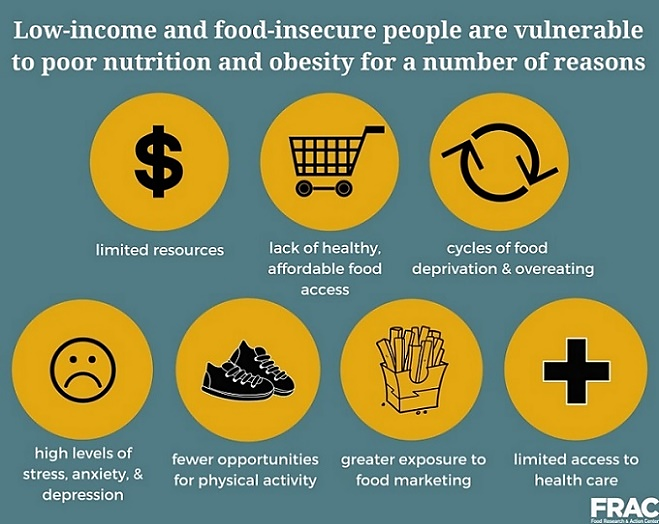 A lack of availability for healthy foods also serves to increase both the United States’ and New Jersey’s ever-growing obesity epidemic, which has proven difficult to manage even in areas where healthy and nutritious foods are an option. In areas of the state were these foods are not readily available an increasing number of families, youth, and adults will have no choice but to turn to less healthy alternatives. The negative outcomes of being limited to such a diet are exponential in their potential impacts on both one’s quality of life, and the community they live in as a whole. A lack of availability for healthy foods also serves to increase both the United States’ and New Jersey’s ever-growing obesity epidemic, which has proven difficult to manage even in areas where healthy and nutritious foods are an option. In areas of the state were these foods are not readily available an increasing number of families, youth, and adults will have no choice but to turn to less healthy alternatives. The negative outcomes of being limited to such a diet are exponential in their potential impacts on both one’s quality of life, and the community they live in as a whole.
WHERE IN NJ
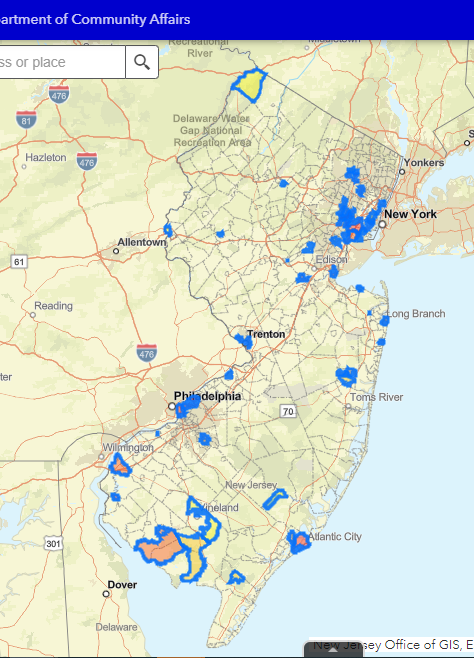 Food deserts are not a problem limited only to one city, environment, or location within New Jersey. Urban and rural areas alike face difficulties obtaining fresh and healthy foods, with various locations like Atlantic City, Camden, Salem County, and Newark all facing issues regarding a lack of access to affordable and nutritious foods. In a part of the nation known as “The Garden State” this is and should be more widely seen as an unacceptable situation for our fellow residents. Food deserts are not a problem limited only to one city, environment, or location within New Jersey. Urban and rural areas alike face difficulties obtaining fresh and healthy foods, with various locations like Atlantic City, Camden, Salem County, and Newark all facing issues regarding a lack of access to affordable and nutritious foods. In a part of the nation known as “The Garden State” this is and should be more widely seen as an unacceptable situation for our fellow residents.
As of January 2022 the New Jersey Economic Development Authority estimates that nearly 1.3 million individuals living within the state can be classified as living within a food desert. These figures are the result of a report which examined food deserts across New Jersey, including the ranking of the 50 most food insecure communities. These communities will be eligible to receive money from the 240 million dollars made available as a part of the Food Desert Relief Act created as a part of the Economic Recovery Act of 2021. Residents of New Jersey are being encouraged to provide input on the proposed list.
View the map here
Map Data Sheet
Examples:
Using the latest data made available by the USDA in 2018 and compiled by other institutions in 2020, three examples of locations facing food insecurity across New Jersey have been provided to aid in visualizing the scope of the issue facing our state:
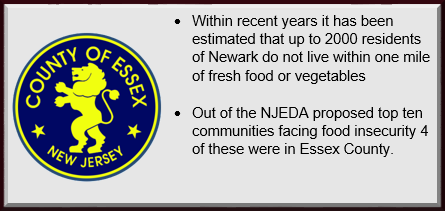 . .
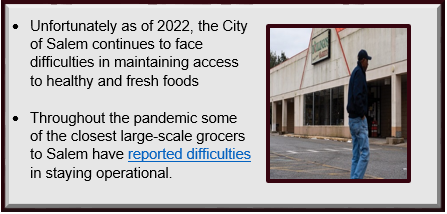
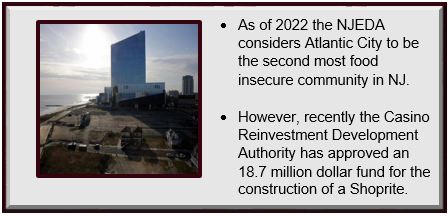
SOLUTIONS
A wide variety of solutions exist in combatting issues with food access and insecurity. CDCs, branches of municipal government, concerned resident groups, and private philanthropists have all shown the capacity to face the challenges presented in a variety of ways. Some of these strategies are as follows, with many being conducted by members of the Network aid in the effort to bring healthy and nutritious foods into the lives of those who need them:
Additional & Alternative Vendors
An obvious solution to combatting a lack of healthy foods in a community is to create more vendors that can make them available to residents.
 Subsidized Supermarkets Subsidized Supermarkets
Grocery chains are beginning to find ways through subsidy programs to create low-cost environments for fresh and healthy foods in areas traditionally seen as food deserts. Often incentivizing healthy alternatives such as grilled instead of fried foods prepared on-site, and advertising various forms of produce over junk food, these types of supermarkets are often the largest-scale and best recognized form of solution. However these can be costly and the most affected by market trends.
Legislation promoting the building/construction of new grocers in recognized food deserts is an idea that has growing recognition among New Jersey’s legislators. Often proposed through the use of tax credits, these programs in combination with anti-food waste initiatives are one form of solution from state itself.
Healthy Corner-stores
While new supermarkets and large-scale grocers are often seen as the ideal solution, a typically more immediate and less difficult alternative exists in using what is already established within a neighborhood. Using this mentality, programs such as the Healthy Corner-store initiative have worked with the owners of small scale food outlets within urban areas to assist them in expanding and introducing healthy options to their stock. The result is timely relief in local areas that may not see large-scale supermarkets and grocery stores developed on a practical schedule.
Community-Based Solutions
New Jersey has also seen community-centric solutions created across various municipalities to combat the consequences of food insecurity.
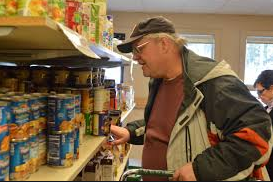 Food Pantries and Soup Kitchens Food Pantries and Soup Kitchens
Food pantries and soup kitchens have long been one of the most reliable forms of combatting food insecurity on a local scale. Often run by local institutions such as CDCs, houses of worship, and other community organizations, these community-run efforts are too often the first and only line of defense between a neighborhood's residents and food insecurity. Click here for a list of food pantries by county
- Food Banks
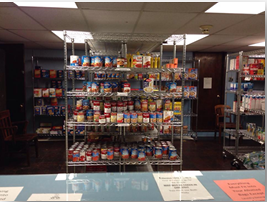 While similar to food pantries in some ways, food banks operate on a much larger scale and typically do not work directly with those facing food insecurity within a community. Instead, their most common form of operation is to act as a storage and distribution point for large quantities of supplies that are then distributed to food pantries, soup kitchens, and other local operations. Though they often work in the background and are not seen by many within a given community they are vital to many areas efforts in curbing food insecurity. While similar to food pantries in some ways, food banks operate on a much larger scale and typically do not work directly with those facing food insecurity within a community. Instead, their most common form of operation is to act as a storage and distribution point for large quantities of supplies that are then distributed to food pantries, soup kitchens, and other local operations. Though they often work in the background and are not seen by many within a given community they are vital to many areas efforts in curbing food insecurity.
 Community Gardens Community Gardens
Community gardens are a growing form of a local solution to a lack of nutritious produce in a local area, and are often funded by CDCs, corporate entities, and resident groups. These small scale solutions provide residents with not only a source of fresh foods, but also an area to both socialize and build valuable skillsets.
Examples of Network Members Fighting Food Insecurity
The Network has multiple members who are involved in combatting food insecurity in a variety of ways across New Jersey.
North Jersey:
 La Casa De Don Pedro’s holiday food and toy drive in the months of November and December collects meal ingredients and gifts for children of all ages (0-18) to distribute over the December holidays. Businesses are also incentivized to directly “adopt” a classroom or school to aid on a larger scale. La Casa De Don Pedro’s holiday food and toy drive in the months of November and December collects meal ingredients and gifts for children of all ages (0-18) to distribute over the December holidays. Businesses are also incentivized to directly “adopt” a classroom or school to aid on a larger scale.
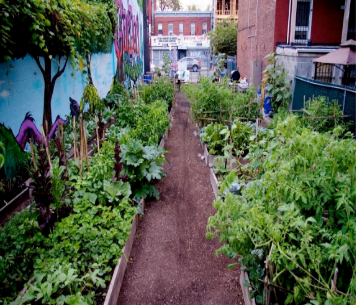
Morris Canal Community Development Corporation through its Lafayette Learning Community Garden is able to assist low-income residents in obtaining healthy foods and help their children become educated about matters of eating well. Morris Canal CDCs members are firm believers that the act of gardening can nourish the body, mind, and soul, creating a lasting impact across generations that is not limited to diet only.
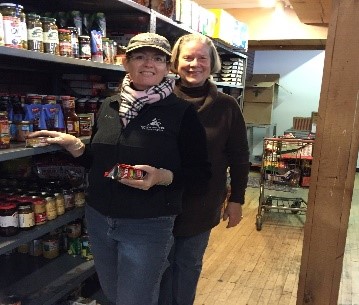
The Northwest New Jersey Community Action Partnership addresses the issue of food insecurity in multiple ways, whether this be through their food bank, food surplus giveaways, backpack initiative, or summer food service program. All of these examples are some NORWESCAPs strategies for bridging all members of the community with healthy lifestyles.
South & Central Jersey:
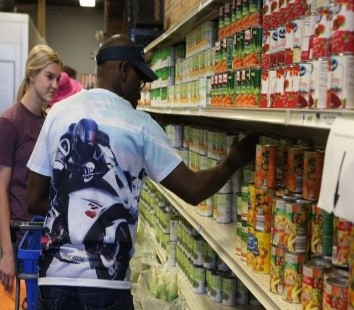
Arm In Arm operates three food pantries in Mercer County that are aimed at helping to fill some of the financial gaps with food that lower-income residents face. Additionally, their home delivery service ensures that up to 150 elderly and housebound residents receive healthy foods with proper nutrition.
 Community Foundation of South Jersey has a Move for Hunger initiative that tackles food insecurity and food waste by mobilizing a network of relocation partners to collect and deliver non-perishable food for struggling families. They also work with the Food Bank of South Jersey to provide an immediate solution to the urgent problem of hunger by providing food to people in need, teaching them to eat nutritiously, and helping them to find sustainable ways to improve their lives. Community Foundation of South Jersey has a Move for Hunger initiative that tackles food insecurity and food waste by mobilizing a network of relocation partners to collect and deliver non-perishable food for struggling families. They also work with the Food Bank of South Jersey to provide an immediate solution to the urgent problem of hunger by providing food to people in need, teaching them to eat nutritiously, and helping them to find sustainable ways to improve their lives.
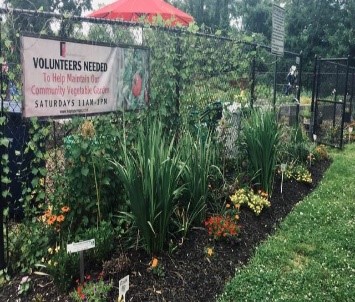
Midtown Urban Renaissance Corporation has been working with First Pentecostal Church, Neptune Township’s Administration, Public Works, Recreation and the Gannett Foundation to help the surrounding neighborhoods create a community garden and improve the area around it and beyond since 2018.
RESOURCES
New Jersey Food Resources:
NJ County Food Resource Guide
Community Food Bank of New Jersey
Food Bank of South Jersey
List of Summer Feeding Sites
SNAP Information:
SNAP Online Application
SNAP Retailer Locator
Required Foods for Snap Retailers
Requirements for Online SNAP Retailers
Food Insecurity Studies:
Feeding America New Jersey Food Insecurity Summary
2019 Food Insecurity in Middlesex County by Rutgers University
Food Insecurity Among Students in New Brunswick
|